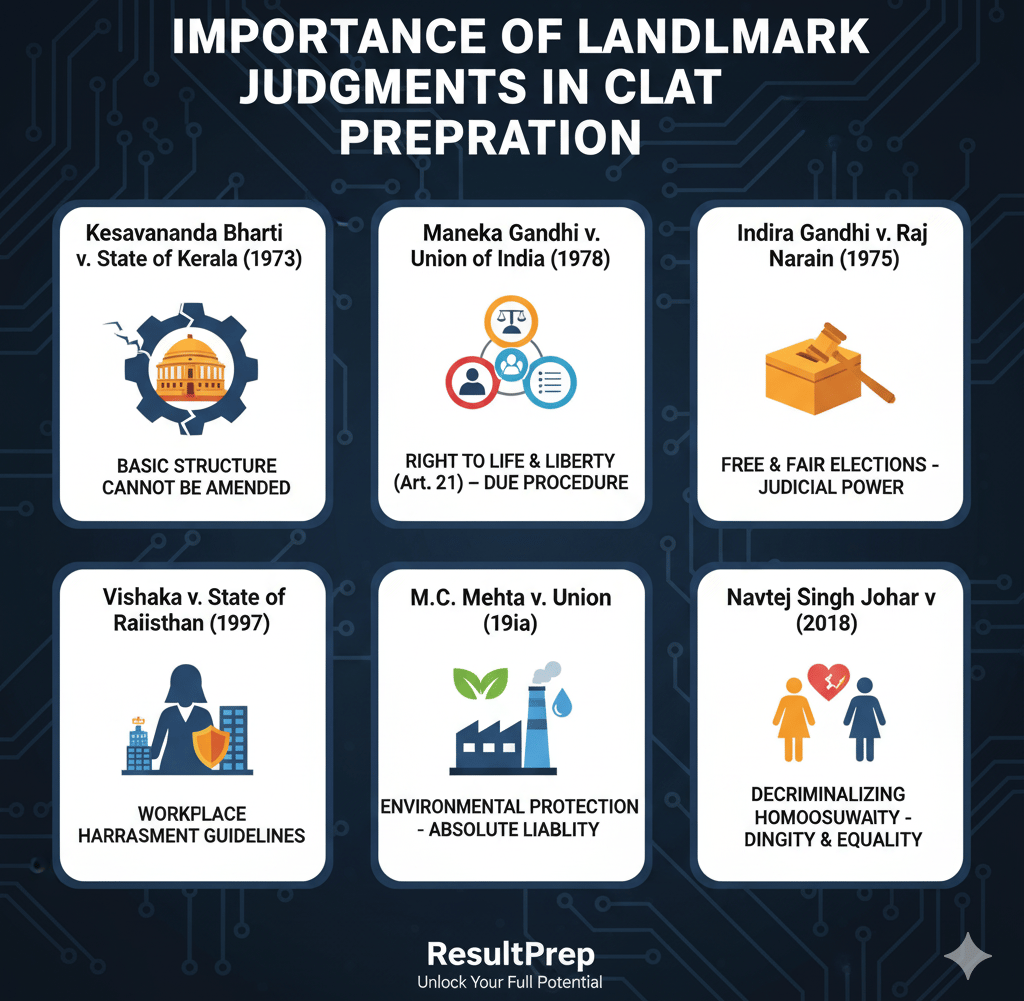Landmark Judgments Every CLAT Aspirant Must Know
Ace CLAT Legal Reasoning with must-know landmark judgments! 📚 From Basic Structure to Workplace Rights and Equality, master the principles that shape India’s law and boost your exam score with ResultPrep Coaching. 🚀
LAW ENTRANCE
9/30/20253 min read


Importance of Landmark Judgments in CLAT Preparation
Landmark judgments form the backbone of India’s legal system. They not only shape the way laws are interpreted but also highlight the evolution of constitutional values such as equality, liberty, and justice. For students preparing for the CLAT exam, knowing these cases is crucial. They often appear in Legal Reasoning passages, Current Affairs questions, and help students connect legal principles with real-world application.
By mastering these judgments, aspirants can improve their analytical ability, strengthen legal knowledge, and boost their scores in the Legal Reasoning section.
Kesavananda Bharati v. State of Kerala (1973) – Basic Structure Doctrine
This case is one of the most significant in Indian constitutional law. The Supreme Court ruled that while Parliament has wide powers to amend the Constitution, it cannot alter its basic structure.
Key takeaway: The Constitution is supreme, and core principles such as judicial review, democracy, and rule of law cannot be destroyed.
Why it matters for CLAT: Expect passages about constitutional amendments, separation of powers, or the limits of parliamentary authority.
Maneka Gandhi v. Union of India (1978) – Article 21 Expanded
In this judgment, the Supreme Court broadened the meaning of Article 21 – Right to Life and Personal Liberty. It held that no person can be deprived of life or liberty except by a just, fair, and reasonable procedure.
Key takeaway: Fundamental rights are interconnected, especially Articles 14, 19, and 21.
Why it matters for CLAT: Legal Reasoning passages on liberty, fairness, or procedural safeguards often link to this case.
Indira Gandhi v. Raj Narain (1975) – Election Dispute and Judicial Power
This case arose from challenges to the election of the then Prime Minister, Indira Gandhi. The judgment emphasized the principle that nobody is above the law.
Key takeaway: Free and fair elections are an essential feature of democracy.
Why it matters for CLAT: Questions on separation of powers, elections, and political accountability may reference this judgment.
Vishaka v. State of Rajasthan (1997) – Workplace Harassment Guidelines
This case set guidelines to address sexual harassment at the workplace. The Supreme Court held that such harassment violates the fundamental rights of women under Articles 14, 15, and 21.
Key takeaway: The judgment filled the legislative gap until the enactment of the POSH Act, 2013.
Why it matters for CLAT: Gender equality and workplace rights remain hot topics for current affairs-based Legal Reasoning questions.
M.C. Mehta v. Union of India – Environmental Protection
This series of cases highlighted the importance of environmental rights. One key ruling was in the Oleum Gas Leak case (1986), where the Supreme Court introduced the principle of absolute liability for industries engaged in hazardous activities.
Key takeaway: Right to life includes the right to a clean and healthy environment.
Why it matters for CLAT: Expect passages on environmental law, industrial pollution, or sustainable development.
Navtej Singh Johar v. Union of India (2018) – Decriminalizing Homosexuality
This judgment struck down Section 377 of the IPC to the extent it criminalized consensual same-sex relations. The Supreme Court emphasized dignity, equality, and individual liberty.
Key takeaway: Fundamental rights apply to all citizens, regardless of gender or sexual orientation.
Why it matters for CLAT: Recent progressive judgments on equality and privacy are common in exam passages.
How to Study Landmark Judgments for CLAT
Focus on principles, not details: You do not need to memorize dates or bench sizes, but focus on the core legal principle.
Relate to current issues: Many CLAT passages connect old judgments to modern debates.
Practice previous year papers: Review how CLAT frames questions on cases.
Make flashcards: Keep short notes summarizing each judgment.
Conclusion
Landmark judgments are more than just case names—they are the foundation of India’s legal and constitutional framework. For CLAT aspirants, they are essential for Legal Reasoning, Current Affairs, and essay writing practice. By studying cases like Kesavananda Bharati, Maneka Gandhi, Vishaka, M.C. Mehta, and Navtej Singh Johar, students not only prepare for exams but also build a deeper understanding of justice and democracy.
At ResultPrep Coaching, we provide detailed case briefs, legal reasoning practice sets, and mock tests to help students master landmark judgments with clarity and confidence.
📞 Call: 8970007497
🌐 Visit: www.resultprep.com
Prepare for the best results!
Achieve your goals with expert coaching and support from ResultPrep.
Contact us:
© 2025. All rights reserved.
Address:
GSS Complex, 2nd Floor,
16th Cross Rd, HMT Layout, Vidyaranyapura, Bengaluru, Karnataka- 560097
